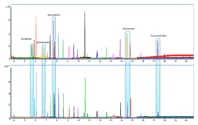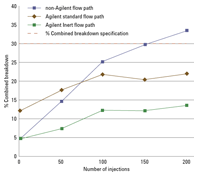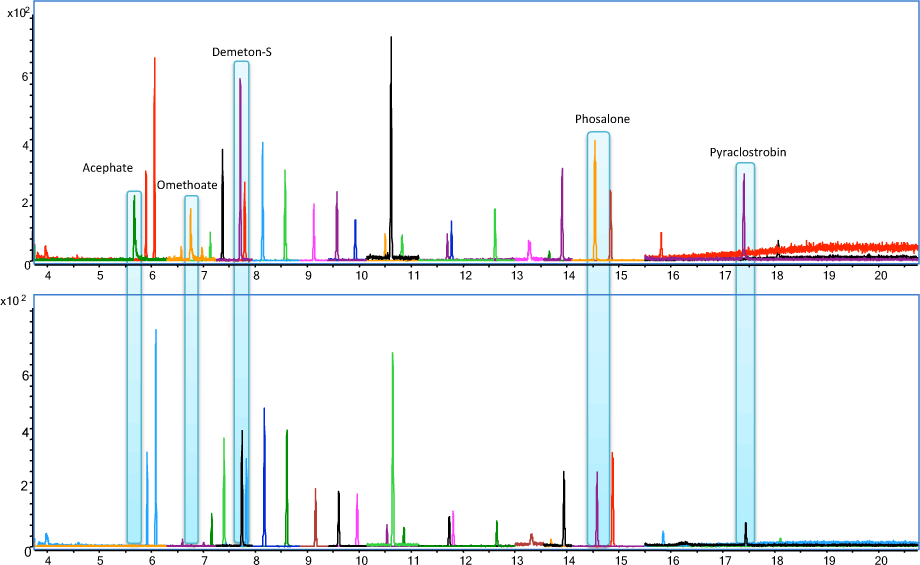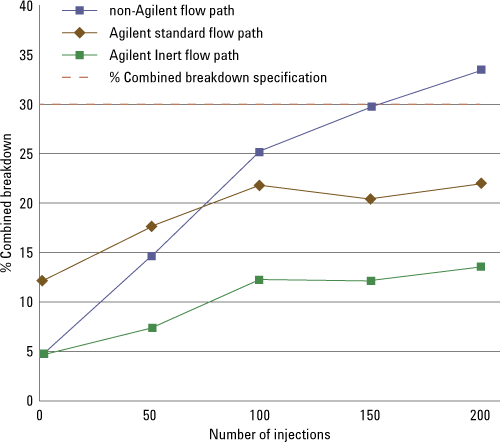Access Agilent eNewsletter, February 2014
>> Update My Profile | Subscribe to Access Agilent | Article Directory

Use the Agilent Inert Flow Path to reliably analyze active pesticides
By Peter Heijnsdijk and Limian Zhao
Agilent GC Applications
Flow path inertness plays a critical role in the accuracy and precision of pesticide analyses, especially for active or labile analytes. The Agilent Inert Flow Path includes Ultra Inert columns and liners, Ultra Inert gold seals, and an inert split/splitless inlet. It provides excellent surface inertness through the entire flow path, prevents loss of analyte response and peak shape distortion, and delivers reliable qualitative and quantitative analyses of pesticides. Other inert supplies, including Agilent UltiMetal Plus Flexible Metal Ferrules and Agilent Capillary Flow Technology devices, are also highly recommended for pesticide analyses in complicated matrixes.
In the following brief examples, we used pesticide probes to compare GC flow paths with and without surface inertness. Full details are available in Agilent application notes 5991-1860EN and 5991-1862EN.
Improve response and peak shape for active pesticides
To minimize accumulation in the environment, many pesticide compounds are intentionally designed to decompose easily. However, this labile feature makes instrumental analyses more difficult, especially when you use GC and GC/MS. The unwanted degradation or adsorption of labile compounds during analysis can result in inaccurate quantitative or qualitative results, or both.
To evaluate Agilent systems for analyses of difficult labile compounds, we analyzed 26 representative and challenging pesticide compounds, including organophosphates, organochlorines, and carbamates.
 Enlarge
Enlarge
Figure 1. Chromatographic comparison of an Agilent Inert Flow Path (above) and standard flow path (below), after injection of a 10 ng/mL pesticide standard.
Figure 1 shows the comparison of multiple reaction monitoring (MRM) chromatograms for 10 ng/mL pesticide solutions with an inert flow path (top) and standard flow path (bottom). Clearly, the inert flow path provided much better performance than the standard flow path, especially for sensitive pesticides such as acephate, omethoate, phosalone, demeton-S, and pyraclostrobin. For these sensitive pesticides, the analyte responses and peak shapes were significantly improved. The inert flow path delivered more symmetrical and sharper peaks for acephate and omethoate. At the lower concentrations shown in Figure 1, these two troublesome analytes were undetectable with the standard flow path. Even at 500 ng/mL, acephate and omethoate peaks were still much smaller and showed significant tailing with the standard flow path [1].
Fewer active sites, less compound degradation
Endrin and DDT are two well-known compounds that can degrade excessively in GC analysis, especially at the inlet. When the inertness of the GC flow path is not well controlled, active sites can initiate degradation so that endrin decomposes to endrin aldehyde and endrin ketone, and DDT degrades to DDE and DDD. Most breakdown reactions occur on hot inlet surfaces. The degradation increases when the GC component’s surface deactivation deteriorates with continuous use. Moreover, the creation of additional active sites increases the breakdown reactions of endrin and DDT. So breakdown of endrin and DDT is a very useful probe to evaluate not only the efficiency of deactivated flow path parts, but also the stability of surface deactivation over time for multiple injections.
 Enlarge
Enlarge
Figure 2. Endrin/DDT combined breakdown over 200 injections for Agilent Inert Flow Path (green), Agilent standard flow path (brown), and non-Agilent deactivated flow path (blue).
Figure 2 shows a comparison of the percentage endrin/DDT combined breakdown over 200 injections (in isooctane) for the Agilent standard flow path, Agilent Inert Flow Path, and non-Agilent deactivated components. The endrin/DDT breakdown on the Agilent Inert Flow Path was well under control with less than 15 percent combined breakdown even after 200 injections. This result met the acceptance criteria for endrin/DDT breakdown.
These results demonstrate that the Agilent Inert Flow Path solution is well suited for high sensitivity analyses of chlorinated pesticides [2].
Sensitive analyses from an insensitive flow path
The Agilent Inert Flow Path significantly improves results by providing higher response, better peak shape, better calibration linearity, and consistency of the entire flow path. These positive outcomes demonstrate that minimization of flow path active sites is critical to achieve accurate, precise, and reliable results for pesticide residue analyses. If you need the best possible results, see how Agilent Inert Flow Path solutions can improve your pesticide analysis.
References
- L. Zhao. “Evaluating Inert Flow Path Components and Entire Flow Path for GC/MS/MS Pesticide Analysis”. Agilent Application Note 5991-1860EN (2013).
- P. Heijnsdijk. “Endrin and DDT Breakdown Evaluation Using an Agilent Inert Flow Path Solution”. Agilent Application Note 5991-1862EN (2013).
>> Update My Profile | Subscribe to Access Agilent | Article Directory

